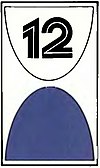
Events Leading
to the
Enactment
of the 1956
Federal-Aid Highway Act
Rapid Recovery of Motor Traffic to Prewar Levels
After the surrender of Japan, the American economy shifted from war to peace with remarkable speed. Huge wartime savings, some $44 billion, created an insatiable market for housing and for all kinds of goods, including new automobiles to replace the decrepit vehicles that had survived the war. Automobile production jumped from a mere 69,532 in 1945 to over 2.1 million in 1946, 3.5 million in 1947 and 3.9 million in 1948.[1]
Reflecting this vast increase in vehicle production, registrations increased 22 percent, from the wartime low of 30.6 million vehicles to 37.4 million vehicles in 1947. (In this period trucks increased by 34 percent.) With the end of rationing and emergency speed controls, highway travel reached its prewar peak in 1946 and began a steady climb of about 6 percent per year that was to continue for decades.[2]
The Nation’s highways were in poor shape to receive this traffic. Most of. the deficiencies disclosed in the 1941 survey of the strategic network still existed in 1946. Under wartime restrictions, the States could do little to remedy them, and, in fact, because of wide-spread operation of overloaded trucks and reduced maintenance, the State highway systems were in worse shape structurally after the war than before.
The Urban Traffic Problem
In and near the cities, hundreds of miles of highways were functionally obsolete because of narrow pavements, ribbon development and insufficient capacity. In the 1920’s and 1930’s, migration of the more affluent inhabitants to outlying suburban areas created expansive thinly spread residential communities surrounding the major cities. This movement to the suburbs, which began in the days of the steam and electric railroads, was greatly accelerated by the private automobile. As the street and highway networks expanded, more and more people found it convenient to live in the suburbs and drive to and from work, but the convenience decreased rapidly as the highways became congested with ever-increasing volumes of vehicles.
The city, county and State highway authorities tried to keep up with the traffic increase, first by widening streets and highways and then by providing special high-capacity roads such as parkways and expressways, commonly financed by bond issues.[N 1] These special facilities expanded the radius of suburban development and attracted so much more traffic that they too became seriously congested.
- ↑ In the prewar period, the outstanding examples of such deluxe facilities were the Westchester County Parkways and the Long Island State Parkway System. The latter, begun in 1925, by 1947 had expanded into a 158-mile network of commuter arteries tying western Long Island to downtown New York.[3] In the west, the Arroyo Seco Parkway between Los Angeles and Pasadena, opened in 1940, was a dramatic demonstration of what could be done to move large volumes of traffic to and from the suburbs.
154
- ↑ 1970 Automobile Facts and Figures (Automobile Manufacturers Association, Detroit, 1970) p. 3.
- ↑ Bureau of Public Roads, Highway Statistics, 1951 (U.S. Dep’t. of Commerce, Washington, D.C., 1953) p. 29.
- ↑ S. M. Shapieo, The Long Island State Parkway System, Convention Group Meetings, New York City, September 24–26, 1947 (AASHO, Washington, D.C., 1947) pp. 112–117.
